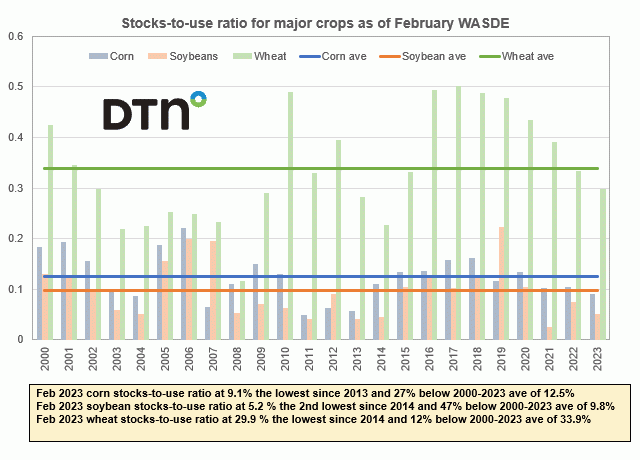Fundamentally Speaking
Feb WASDE Stocks-to-Use Ratios for Major Crops
Prices of key crops continue to trade at historically high levels as we move closer to the start of the 2023 growing season here in the U.S.
One reason is that crop shortfalls linked to adverse weather, restricted imports due to war and trade sanctions, fairly resilient demand despite now being three years into the pandemic and tightening monetary conditions throughout the world has weighed on global economic output.
This has resulted in some of the tightest supplies for corn, soybeans and wheat seen in recent years and very low stocks-to-use ratios.
P[L1] D[0x0] M[300x250] OOP[F] ADUNIT[] T[]
This graphic shows the stocks-to-use ratio as reported in the USDA's February WASDE report from 2000 to the figures furnished last week for U.S. corn, wheat and soybeans.
Corn stocks at 1.267 billion bushels (bb) are the lowest since 2013 as is the stocks-to-use ratio at 9.1% and 27% below 2000-2023 average stocks-to-use ratio of 12.5%.
February 2023 soybean stocks were pegged at 225 million bushels (mb), the second lowest since 2014 as is the stocks-to-use ratio at 5.2 %, and is 47% below the 2000-2023 average of 9.8%.
Finally, February 2023 wheat stocks at 568 mb are the lowest since 2014 as is the stocks-to-use ratio at 29.9%, which is 12% below the 2000-2023 average of 33.9%.
This situation could change in the months ahead as some estimates for 2023/24 corn and soybean stocks are in excess of 2.0 bb and 300 mb respectively based on expectations of higher acreage and a return to trend yields.
As for wheat, while last month's USDA 2023 winter wheat seedings report came in quite a bit above trade expectations, a lot of questions remain about yields given the crop went into dormancy last fall in some of the worst shape ever due to longstanding drought conditions throughout the Plains that are still present today.
(c) Copyright 2023 DTN, LLC. All rights reserved.





Comments
To comment, please Log In or Join our Community .